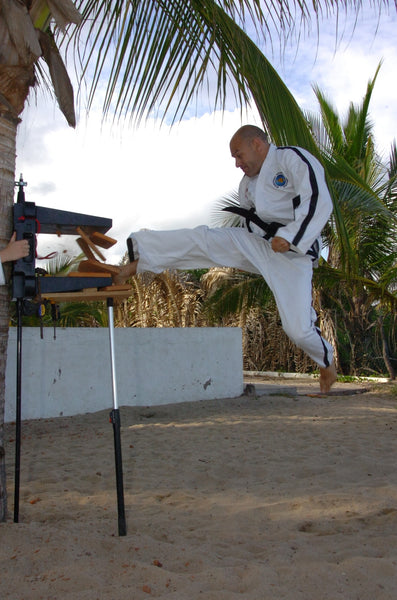Front Elbow

This is a forward direction technique that is safer to perform and prepare for than a forefist punch. It also has the advantage of involving fewer small joints, so the areas that make a technique vulnerable to power loss are much fewer, making it easier to generate great power. The striking tool is an area approximately the width of your palm in front of the elbow towards the little finger. As this is bone and skin (no soft tissue), it shares the advantage of a forefist punch of striking the target with a hard surface, like with a hammer or bat. The disadvantage is that BECAUSE there is no soft tissue to cushion the
impact, there can be swelling or damage if you have not been conditioning the impact point.
However, the forearm is a larger bone than the knuckles, so the risk of damage is greatly
reduced. Placing a pad in front of the boards to cushion the blunt force of the initial impact is recommended in the initial stages of training. Then as you become more accomplished with the technique, gradually reduce the thickness of the pad until you are comfortable with striking the target without any pad at all.
The height of the middle of the board should be approximately one and a half fists (vertical) below your shoulder when you are standing beside the board.
To get the correct distance, stand beside the board with the striking shoulder just touching the edge of the board. Ensure your heels are in line with the front edge of the board (resulting in your being slightly behind the board). Step back with the same foot as the breaking arm into a good walking stance. This will be your final position once you have completed your break. Lift the breaking arm up horizontal with the thumb side of the hand towards your chest and in line with the opposite pectoral muscle. The forearm should be parallel to the chest with a ninety-degree bend in the elbow.
The striking tool should be on the front of the board but towards the edge (not middle). For the final starting position, pull/shift the front foot back into an L or back stance with the weight on the same foot as the breaking arm.
Although front elbow strike can be done stepping, double stepping, etc., the easiest way
to learn the technique is a modified version of “on the spot.” Simply lift the front leg up while leaning back and rotate slightly away from the target (similar to a baseball pitcher winding up) while keeping the toes pointing up to the ceiling. Bend the rear knee to prepare it to launch the body forward. Point the non-breaking hand towards the target (palm down), and lift the striking elbow horizontal with the elbow pointing backward and palm facing upward.
As you step into the strike, rise slightly up on the ball of the rear foot, and step/drive your front foot forward close to the original position it was in when you measured beside the board. Snap your hips and body forward to a full facing position (shoulders and chest parallel to the board but leaning forward slightly.)
Simultaneously, drive the striking arm forward into the board rotating on impact so that the thumb side of the hand is towards your chest, palm down, and pull the other hand back to your hip, rotating to a palm up position.
Common Mistakes
Striking with the point of the elbow: you are too far away to start and/or are twisting into the break.
Do NOT grab the striking hand with the other and twist. (This changes the break into a different, less powerful break.)
Striking the corner/edge of the board: you are stepping too far behind the board and/or are trying to “pull” the board into breaking instead of smashing through it using your elbow with your body behind it pushing you through.
Also in News


